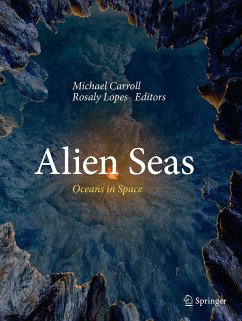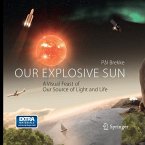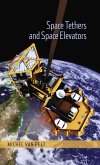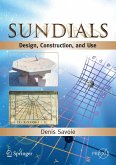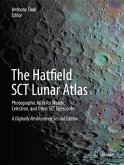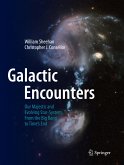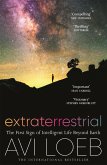Oceans were long thought to exist in all corners of the Solar System, from carbonated seas percolating beneath the clouds of Venus to features on the Moon's surface given names such as "the Bay of Rainbows" and the "Ocean of Storms." With the advent of modern telescopes and spacecraft exploration these ancient concepts of planetary seas have, for the most part, evaporated. But they have been replaced by the reality of something even more exotic. For example, although it is still uncertain whether Mars ever had actual oceans, it now seems that a web of waterways did indeed at one time spread across its surface.
The "water" in many places in our Solar System is a poisoned brew mixed with ammonia or methane. Even that found on Jupiter's watery satellite Europa is believed similar to battery acid. Beyond the Galilean satellites may lie even more "alien oceans." Saturn's planet-sized moon Titan seems to be subject to methane or ethane rainfall. This creates methane pools that, in turn, become vast lakes and, perhaps, seasonal oceans. Titan has other seas in a sense, as large shifting areas of sand covering vast plains have been discovered. Mars also has these sand seas, and Venus may as well, along with oceans of frozen lava. Do super-chilled concoctions of ammonia, liquid nitrogen, and water percolate beneath the surfaces of Enceladus and Triton? For now we can only guess at the possibilities.
'Alien Seas' serves up part history, part current research, and part theory as it offers a rich buffet of "seas" on other worlds. It is organized by location and by the material of which various oceans consist, with guest authors penning specific chapters. Each chapter features new original art depicting alien seas, as well as the latest ground-based and spacecraft images. Original diagrams presents details of planetary oceans and related processes.
The "water" in many places in our Solar System is a poisoned brew mixed with ammonia or methane. Even that found on Jupiter's watery satellite Europa is believed similar to battery acid. Beyond the Galilean satellites may lie even more "alien oceans." Saturn's planet-sized moon Titan seems to be subject to methane or ethane rainfall. This creates methane pools that, in turn, become vast lakes and, perhaps, seasonal oceans. Titan has other seas in a sense, as large shifting areas of sand covering vast plains have been discovered. Mars also has these sand seas, and Venus may as well, along with oceans of frozen lava. Do super-chilled concoctions of ammonia, liquid nitrogen, and water percolate beneath the surfaces of Enceladus and Triton? For now we can only guess at the possibilities.
'Alien Seas' serves up part history, part current research, and part theory as it offers a rich buffet of "seas" on other worlds. It is organized by location and by the material of which various oceans consist, with guest authors penning specific chapters. Each chapter features new original art depicting alien seas, as well as the latest ground-based and spacecraft images. Original diagrams presents details of planetary oceans and related processes.
From the reviews:
"Space artist and science writer Carroll (The Seventh Landing, CH, Feb'10, 47-3129) and research scientist Lopes (NASA Jet Propulsion Laboratory, Caltech) provide an overview of fluids in Earth's solar system and possibly elsewhere. ... Summing Up: Recommended. General readers." (N. W. Hinman, Choice, Vol. 51 (9), May, 2014)
"The slender volume contains essays by many active planetary scientists who also happen to be excellent writers ... . they each deliver an up-to-date yet concise and accessible summary of the state of planetary science for each different kind of world in the solar system. ... the volume is abundantly illustrated with both well-selected photos and lots of artworks by Michael Carroll ... . This is an excellent gift book for the space enthusiast in your life, or even for a science-obsessed high school student." (Emily Lakdawalla, The Planetary Society - Emily's Blog planetary.org, December, 2013)
"Through beautifully-written essays by some of the most knowledgeable scientists in the field ... this book takes us by the hand, lifts us off the Earth, takes us to the edges of those alien seas, sits us down on their beaches, and tells us their stories. ... this book would be worth buying. ... this book's publication is very timely, and offers readers a great opportunity to 'catch up' with the state of this area of planetary science. ... Get it. You'll love it." (Cumbrian Sky, cumbriansky.wordpress.com, December, 2013)
"Lopes and Carroll have done a masterful job of melding chapters that feature contributions by themselves along with other leading scientists and planetary researchers. ... this book is a treasure trove of information. ... volume contains 105 illustrations, with 60 illustrations in color, including new artwork by the talented Michael Carroll that depicts alien seas as well as the latest ground-based and spacecraft images. You'll find a wonderfulread here ... with the text punctuated by original diagrams that detail planetary oceans and related processes." (Spacecoalition.com, December, 2013)
"Space artist and science writer Carroll (The Seventh Landing, CH, Feb'10, 47-3129) and research scientist Lopes (NASA Jet Propulsion Laboratory, Caltech) provide an overview of fluids in Earth's solar system and possibly elsewhere. ... Summing Up: Recommended. General readers." (N. W. Hinman, Choice, Vol. 51 (9), May, 2014)
"The slender volume contains essays by many active planetary scientists who also happen to be excellent writers ... . they each deliver an up-to-date yet concise and accessible summary of the state of planetary science for each different kind of world in the solar system. ... the volume is abundantly illustrated with both well-selected photos and lots of artworks by Michael Carroll ... . This is an excellent gift book for the space enthusiast in your life, or even for a science-obsessed high school student." (Emily Lakdawalla, The Planetary Society - Emily's Blog planetary.org, December, 2013)
"Through beautifully-written essays by some of the most knowledgeable scientists in the field ... this book takes us by the hand, lifts us off the Earth, takes us to the edges of those alien seas, sits us down on their beaches, and tells us their stories. ... this book would be worth buying. ... this book's publication is very timely, and offers readers a great opportunity to 'catch up' with the state of this area of planetary science. ... Get it. You'll love it." (Cumbrian Sky, cumbriansky.wordpress.com, December, 2013)
"Lopes and Carroll have done a masterful job of melding chapters that feature contributions by themselves along with other leading scientists and planetary researchers. ... this book is a treasure trove of information. ... volume contains 105 illustrations, with 60 illustrations in color, including new artwork by the talented Michael Carroll that depicts alien seas as well as the latest ground-based and spacecraft images. You'll find a wonderfulread here ... with the text punctuated by original diagrams that detail planetary oceans and related processes." (Spacecoalition.com, December, 2013)

